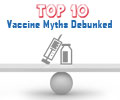Thanks to the approval of vaccine against pneumococcal bacteria for young children in 2000, the rates of invasive pneumococcal disease (IPD) have decreased significantly.
Thanks to the approval of vaccine against pneumococcal bacteria for young children in 2000, the rates of invasive pneumococcal disease (IPD) have decreased significantly. While on the other hand the rates of IPD caused by non-vaccine strains are on the rise.
Researchers from the Centers for Disease Control and Prevention (CDC) report their results today (March 18) at the 2008 International Conference on Emerging Infectious Diseases in Atlanta, Georgia.“This vaccine is continuing to provide a very substantial public health impact 6 years after its introduction. We estimate that between 2001 and 2006, 170,000 cases and 9,800 deaths were prevented as a result of this vaccine,” says Matthew Moore of the CDC, a lead researcher on the study.
Streptococcus pneumoniae, also called pneumococcus, is one of the most common causes of bacterial pneumonia and deadly bloodstream infections in the United States. It can also cause bacterial meningitis in children and adults. In its less severe forms it commonly causes ear infections. Pneumococcus bacteria can be found colonizing many people’s noses without causing infection. Why it suddenly invades the body and causes disease is unknown.
A vaccine against pneumococcal disease has been available for adults and children over 2 years of age since the 1980s, but in 2000 a new vaccine, known as PCV7, was approved by the FDA for children under 5 years of age.
The CDC has been tracking the incidence of IPD, the most severe form of the disease – defined as meningitis or a bloodstream infection, which can include some cases of pneumonia – since the introduction of the vaccine. Moore and his colleagues compared rates of IPD in 2006 with reported rates for 1998-1999, just before PCV7 was introduced.
The researchers found a significant decline in IPD rates for all age groups (-78%, under 5 years; -38%, 5-17 years; -39%, 18-49 years; -14%, 50-64 years; -32%, 65-79 years; and -42%, 80 years and older) with even greater declines in IPD caused by those strains included in the PCV7 vaccine. The incidence of IPD caused by strains not included in the vaccine rose by 40%. One of the non-vaccine strains, 19A showed an increase of 264%, but Moore cautions that because these strains were relatively uncommon before the introduction of the vaccine, the increase in actual numbers is still small.
Advertisement
The introduction of PCV7 may have also helped solve an enduring mystery associated with IPD. The incidence of the disease is seasonal with rates running 5 times higher in the winter, but there is also a sharp but unexplained spike that occurs annually in older adults during the weeks around January 1.
Advertisement
“Timing of the spikes and the predominance of older adults suggest the spikes may be related to older adults’ increased exposure to young children around the winter holidays,” says Walter, who also presented his data at the meeting. The observation that spikes diminished after introduction of PCV7 gives further indication that vaccination of children limits disease not only in children, but also in adults. Many of these infections may be preventable with pneumococcal polysaccharide vaccine, which targets 23 different serotypes and is recommended for all adults 65 years of age and older.
Source-Eurekalert
KAV/L







